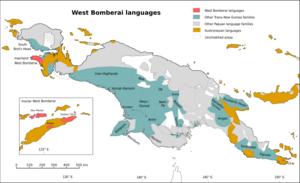Social:West Bomberai languages
| West Bomberai | |
|---|---|
| Geographic distribution | West New Guinea, East Timor |
| Linguistic classification | Trans–New Guinea
|
| Subdivisions |
|
| Glottolog | west2604 (mainland West Bomberai)[1] timo1261 (Timor–Alor–Pantar)[2] |
 Map: The West Bomberai languages of New Guinea
The West Bomberai languages
Other Trans–New Guinea languages
Other Papuan languages
Austronesian languages
Uninhabited | |
The West Bomberai languages are a family of Papuan languages spoken on the Bomberai Peninsula of western New Guinea and in East Timor and neighboring islands of Indonesia.
Languages
Two of the languages of the mainland, Baham and Iha, are closely related to each other; the third is distant, forming a third branch of the family along with the Timor–Alor–Pantar languages:[3]
- Karas isolate
- Mbahaam–Iha: Baham (Mbaham), Iha
- ? Timor–Alor–Pantar
Ross (2005) classified Timor–Alor–Pantar with the mainland West Bomberai languages, although this connection is not universally accepted. Usher found that the Timor–Alor–Pantar languages resides within the West Bomberai languages, and is not just their closest relative. This suggests that Timor–Alor–Pantar may have been the result of a relatively recent migration from New Guinea, perhaps arriving in the Timor area shortly before the Austronesian languages did.
Classification
Ross (2005) classifies Timor–Alor–Pantar with the West Bomberai languages, the two groups forming a branch within West Trans–New Guinea. Based on a careful examination of new lexical data, Holton & Robinson (2014) find little evidence to support a connection between TAP and TNG.[4] However, Holton & Robinson (2017) concedes that a relationship with Trans-New Guinea and West Bomberai in particular is the most likely hypothesis, though they prefer to leave it unclassified for now.[5]
Pronouns
Ross (2005) reconstructs the pronouns of the mainland languages as *na 1sg, *ka 2sg, *bi(r) 1ex, *in 1in, *ki 2pl, of which 1sg, 2sg, and 2pl correspond to proto-Trans–New Guinea.
gloss Proto-Mbahaam–Iha enemy / evil *[a]kʷorou wood / tree *atokʷ nut *[i]kʷijaren needle *ind[o/u]p cook *[i]piek fruit / seed *is dog *jambar wave(s) *jembar light (weight) *jeroŋg flat land / dry land / wide *joun slave *kajam cook / cooked *kajir torch *kajiwor yawn *kamar sun *kaminV war *kambir head *kanda sharp *kaŋgap grass *kaŋgʷam moon *kapas sneeze *kapasi vagina *kar yam (sp.) *karepot face *kemeir sweet *kemeŋ see / sense *ken[a / e][t] know *kende eye *kendjep water / river *kira star / firefly *kis-kis[a] hear / listen *komen grub *kos[um] father's older sister *kowar[a/o]p snake *kowus sweat *kuturuk pig *kundur ten *kʷara carry *kʷarok foot / leg / claw *kʷeji[t/s] raw / unripe / young *kʷen nest *kʷ[e]r[e/i] village *kʷies ear *kʷier boil (n.) *kʷirembus good *kʷosi voice / language *mak child *mandja ginger *maŋ louse *mein inside *mejer[e] spider web *[me]ŋgaŋgam neck / throat *mesek sit *mesen mouth *[mi]sin banana *moŋgʷo sow *mos chin *munduk ~ *ndumuk flying fox *mbajer thick *mbaŋgor star / firefly *mbap sugarcane *mbes white *mbiwoŋg yellow *mbuk younger sibling *naka man / male *nami older sister *nan stand *nander guest / friend *nareit eat *n[a/o]wa older brother *nen name *nie stairs / ladder *nieŋ hide *niŋgis[i] loft / ceiling *ndaram sea snail *ndoman shoot (n.) *ndum sleepy / nod off *ndura thatch *ŋgambur[a] land snail *ŋgawarambuk weave *ŋgeit tongue *ŋgeŋgap swollen *ŋgombor raft / vessel *ŋguwas snore *ŋgʷor[o/u]s bee *ŋgʷ[o/u]n[a] one *[o]kʷo[no] skin / bark / covering *pak ask *pande[s] say / speak *pare fly (v.) *par[o/u] earwax *pek fish trap *per diarrhea *peres stingray *pot wash *pouk ashes *poun root *pur palm / sole *pVram smile *pVri burp / belch *pVrus drink *r[o/u]s cockroach *saŋgʷon old / worn out *sap[ij]ok thin / flat *seke[t] sand *semeŋg black *senek hot / warm *sɛp be ill / sick *serere hoarse *sejiŋ fish *sejir open *seŋgiek earth / world *sirijet ground / below *s[iw]or younger / youngest child *sombi[t] breast *son heavy *taŋgier fence / teeth *tap pointed *tep cluster / bunch *[te]rem thigh *t[iw]on bone *tokar elbow / wrist / knee *toŋgʷon spit *top hit *tos sit with legs to the side *totom woman / female *t[o/u]mb[o/u]r ridgepole / roof *tumbis five *tumbu bay *watjar stone *war bite *warik two *[wa]rik earthquake *weŋg-weŋg go *wes blood *wiek tree *w[i]r[a] sky *woŋg tail *wor breath / breathe *wosou clan / relatives *wotour egg *wun
References
- ↑ Hammarström, Harald; Forkel, Robert; Haspelmath, Martin, eds (2017). "West Bomberai". Glottolog 3.0. Jena, Germany: Max Planck Institute for the Science of Human History. http://glottolog.org/resource/languoid/id/west2604.
- ↑ Hammarström, Harald; Forkel, Robert; Haspelmath, Martin, eds (2017). "Timor–Alor–Pantar". Glottolog 3.0. Jena, Germany: Max Planck Institute for the Science of Human History. http://glottolog.org/resource/languoid/id/timo1261.
- ↑ New Guinea World, West Bomberai
- ↑ Holton, Gary; Robinson, Laura C. (2014), "The linguistic position of the Timor-Alor-Pantar languages", in Klamer, Marian, Alor Pantar languages: History and Typology, Berlin: Language Sciences Press, pp. 155–198, doi:10.17169/langsci.b22.48
- ↑ Holton, Gary; Robinson, Laura C. (2017), "The linguistic position of the Timor-Alor-Pantar languages", in Klamer, Marian, Alor Pantar languages: History and Typology Second Edition, Berlin: Language Sciences Press, pp. 147–190, doi:10.5281/zenodo.437098
